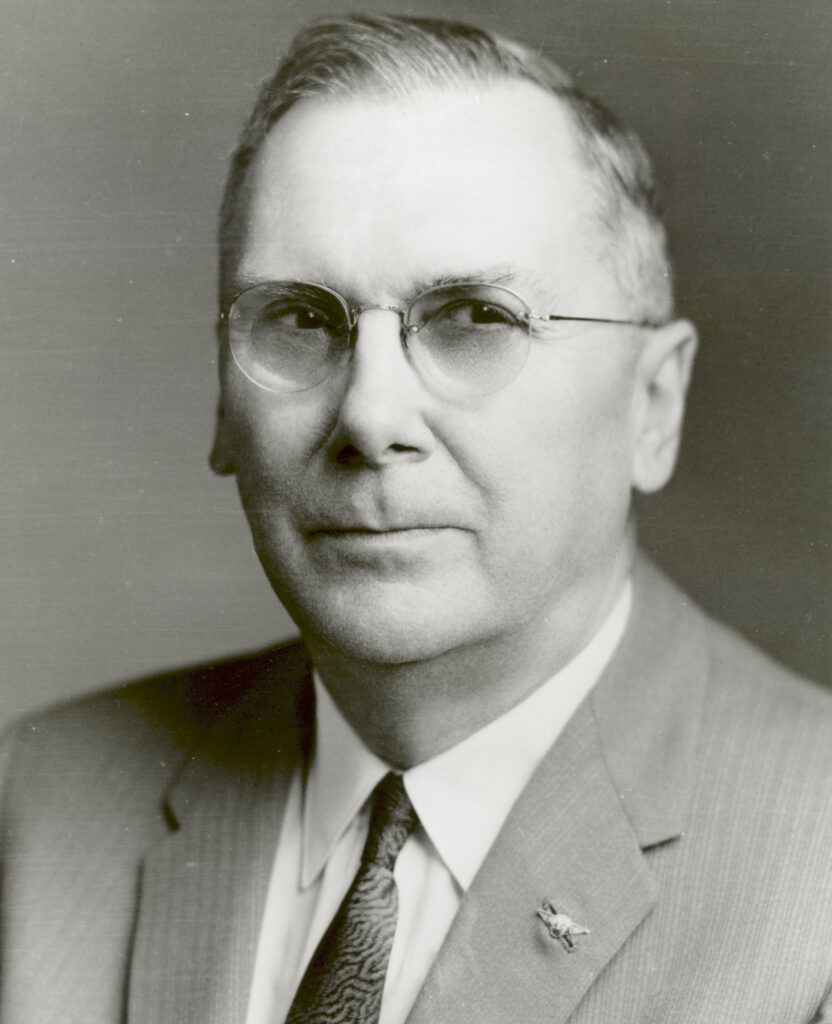Helped establish NASA and served as its Deputy Administrator.
Hugh Latimer Dryden was born in Pocomoke City, Maryland on July 2, 1898. His father lost the family farm during the financial “Panic of 1907” and moved to Baltimore to be a streetcar conductor. In 1913, at the age of 14, Hugh Dryden received a high school diploma from Baltimore City College, its youngest-ever graduate. He enrolled in Johns Hopkins University on a scholarship and completed a four-year Bachelor of Arts course in three years, graduating with honors in 1916. He received a Master’s Degree in Physics from Johns Hopkins in 1918. His thesis was “Airplanes: An Introduction to the Physical Principles Embodied in Their Use.”
In June 1918, Hugh Dryden began working at the National Bureau of Standards as an inspector of gauges while also enrolled in the Department of Physics at Johns Hopkins University. He received a Ph.D. in Physics and Mathematics in the spring of 1919, the youngest student ever to have received a doctoral degree from John Hopkins.
In 1920, Dr. Dryden was promoted to head the Bureau’s Aerodynamics Section. In 1924, he helped make some of the earliest studies of airfoil characteristics near the speed of sound at a time when airplane engines could not exceed 300 miles per hour. He was promoted to Chief of the Mechanics and Sound Division of the Bureau in 1934, and in January 1946, became its Assistant Director. Six months later he was named Associate Director.
In World War II, Dr. Dryden served on several technical groups advising the Armed Forces on aeronautical matters and guided missiles. As head of the Washington project of the National Defense Research Committee, he led the development of America’s first guided missile successfully used in combat, the radar-homing “Bat.” This achievement won him the Presidential Certificate of Merit in 1948. He had been a member of the National Advisory Committee for Aeronautics (NACA) since 1931 and served on several wartime committees advising the Joint Chiefs of Staff, NACA, the Army Ordnance Department, and the Army Air Forces, on guided missiles. Following the end of the war, he continued his interest in the Bureau’s guided missile development program.
In 1945, Dr. Dryden was named Deputy Scientific Director of the Army Air Forces’ Scientific Advisory Group appointed by General “Hap” Arnold to prepare a report as a guide for future research and development programs. With this group, Dryden traveled to Germany, France, England, and Switzerland studying foreign scientific efforts in the development of aeronautics and aerial weapons, especially guided missiles. In 1946 the Army awarded him the Nation’s second highest civilian decoration, the Medal of Freedom, for “an outstanding contribution to the fund of knowledge of the Army Air Forces with his research and analysis of the development and use of guided missiles by the enemy.”
In 1947, Dryden resigned from the Bureau of Standards to become Director of Aeronautical Research at NACA. In 1949, he was promoted to Director of NACA. In this capacity, he had charge of an expanding research organization with some 6,000 employees, three large laboratory centers, and two smaller research stations.
In addition to overseeing NACA, Dr. Dryden was also a member of several scientific advisory committees to government agencies. These included the Technical Advisory Panel on Aeronautics, Department of Defense; the Scientific Advisory Board of the Chief of Staff, United States Air Force; the Scientific Advisory Committee to the President; the Interdepartmental Committee on Scientific Research and Development (Chairman, 1951-55); the Scientific Advisory Committee of the Ballistics Research Laboratory, Aberdeen Proving Ground, and the Advisory Group for Aeronautical Research and Development (AGARD) for the North Atlantic Treaty Alliance. Dryden was also a founding member of the National Academy of Engineering.
Hugh Dryden wrote seventeen technical reports for NACA, dealing with the properties of airfoils at high speeds, wind-tunnel investigations, boundary layer and turbulence, noise suppression, and other aeronautical matters. He edited the Journal of the Institute of the Aeronautical Sciences from 1941 to 1956, and in 1950 received the Daniel Guggenheim Medal for “outstanding leadership in aeronautical research and fundamental contributions to aeronautical science.” In 1955 he received the Wright Brothers Memorial Trophy for “significant public service of enduring value to aviation in the United States.”
When the National Aeronautics and Space Administration (NASA) replaced NACA in 1958, Dr. Dryden served as NASA’s Deputy Administrator in Washington, D.C. from August 19, 1958, until his death from cancer on December 2, 1965. During that period he played a key role in America’s first manned space programs, Projects Mercury and Gemini. In 1976, the NASA Flight Research Center at Edwards Air Force Base was renamed the NASA Hugh L. Dryden Flight Research Center. Dryden Crater on the Moon is also named for him.

